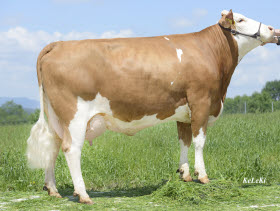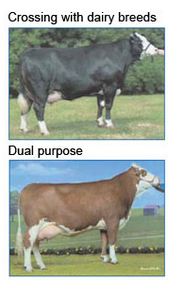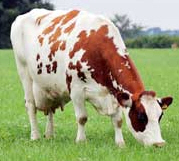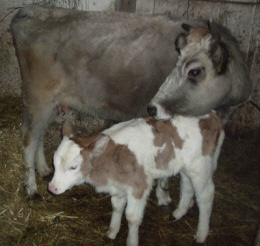



Fleckvieh
The breed is a dual-purpose animal with a dairy focus.

To read about the Simmental click here
History
1870The import of yellow colored bulls from the Swiss Simmental region and cross-breeding with local red and white spotted Austrian cattle (Fleckvieh) results in a medium stature and very robust breed in various shades of Color and markings. The variety in color is of no significance as far as usage or genetic properties are concerned.
1894Foundation of the first Austrian Simmental Fleckvieh Breeding Association.
As late as 1950The top priority was milk, meat and work (featuring superior fitness and an even temper as a basis for balanced breeding).
After 1975Milk and fitness were given increased attention while still keeping an eye on meat output.
1997Introduction of the Total Merit Index as a very balanced Breeding Aim for milk, beef and fitness.
Characteristics
Recently, great gains have been made in the genetic milk productiveness of the Fleckvieh through breed management to the point that the Fleckvieh rivals pure milk producing dairy breeds. Special value is placed on the Fleckvieh’s fitness characteristics including fertility, longevity, calving ease, udder health, milking speed, somatic cell count, and persistence. A large percentage of young Fleckvieh cattle are on alpine grazing which results in good overall health and longevity of life.
Breeding target: 38 per cent milk, 16 per cent beef, 46 per cent fitness
Fleckvieh cattle exhibit good development and performance capacity along with good conformation. 6,000 kg milk in the 1st lactation and over 7,000 – 9,000 kg milk in later lactations with 4.2 per cent fat and 3.7 per cent protein.
Beef performance:
- Daily gain: 1.44 kg
- Carcass weight: 57.2 per cent
- EUROP classification E and U: > 85.7 per cent
- Simmental/Fleckvieh global population: 41 million
- Fleckvieh population Austria: 1,600,000
- Share of breed: 85 per cent of the cattle in Austria are Fleckvieh
- Registered cows: 273,068
- Herds: 16,413
- Live weight: 650 – 850 kg
- Height of the rump: 140 – 150 cm
Statistics
Picture courtesy of Fleckvieh Society of Australia Inc.
Comparative
Distribution
Fleckvieh can be found from the mountains of the Alps to the wide plains east of Vienna.
The breed has been globally adapted across Europe, South America, Australia and New Zealand, as well as South Africa and the USA
As one travels around the world it is easy to see why Fleckvieh have maintained such a presence in the beef cattle industry. The numbers of Simmental cattle, in the world population, is second only to Zebu. And, again, the reason is adaptability and proven genetics that are a century old.
In some countries the color has changed and type has been modified to meet environmental and market demands, but the genetic base of Fleckvieh continues to provide the base for superior performance.
To read about the Simmental click here
References
http://www.genetic-austria.at/



